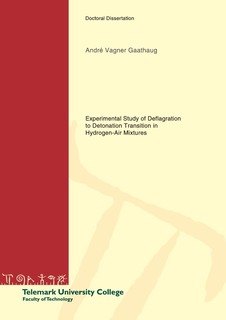| dc.contributor.author | Gaathaug, André Vagner | |
| dc.date.accessioned | 2015-04-16T12:13:12Z | |
| dc.date.accessioned | 2017-04-19T12:10:45Z | |
| dc.date.available | 2015-04-16T12:13:12Z | |
| dc.date.available | 2017-04-19T12:10:45Z | |
| dc.date.issued | 2015-04-29 | |
| dc.identifier.citation | Gaathaug, A.V. Experimental Study of Deflagration to Detonation Transition in Hydrogen-Air Mixtures. Doctoral dissertation, Telemark University College, 2015 | |
| dc.identifier.isbn | 978-82-7206-392-3 | |
| dc.identifier.issn | 1893-3068 | |
| dc.identifier.uri | http://hdl.handle.net/11250/2437782 | |
| dc.description.abstract | Gas explosions in a square channel have been investigated with a main focus on the deflagration to detonation transition (DDT). The gas mixtures were hydrogen and air at different concentrations. This work have been motivated by issues of process safety and hydrogen infrastructure development. There is a need to understand the deflagration to detonation transition from a safety perspective. Recent accident have shown possibilities of DDT in premixed fuel and air. At present there are no software tools capable of predicting DDT in real scenarios, and there is a need to produce accurate experimental data for validation, but also a better understanding of the physics related to DDT. The experiments presented in this thesis were performed in a square channel with transparent side walls and one obstacle. The obstacle was placed 1m from the closed ignition end, and the first results chapter presents the experimental study of flame propagation from ignition up to the obstacle. The ignition source was both a single spark and a distributed ignition, were the latter was assumed to produce a 2 dimensional flame front. The main conclusion of this study was that the 2D assumption was only valid up to the point of tulip flame formation. The study of DDT was divided in two parts, one in homogeneous gas mixtures, the other regarding inhomogeneous gas mixtures. The homogeneous gas mixture experiments showed that transverse waves were important for the DDT, but also that these waves originated from far behind the leading tip of the deflagration. This conclusion was also found in a numerical study using the in-house FLIC code developed by Dr. Vaagsaether. The study of inhomogeneous gas mixtures were done to investigate if inhomogeneities increased the likeliness of DDT. The conclusion was that it was not the case in this particular setup and method. However, other interesting results were found regarding detonation propagation in layers of reactants bound by a wall and a layer of air. The propagation mechanism of detonations in a reactive layer was also studied using the FLIC code, where it was observed a expansion effect and a merging of triple points at the top wall. This was qualitatively similar as the experimental results. | |
| dc.language.iso | eng | |
| dc.publisher | Telemark University College | |
| dc.relation.ispartofseries | Doctoral dissertations at TUC;2015:1 | |
| dc.subject | gas explosions | |
| dc.subject | hydrogen gas explosions | |
| dc.subject | DDT | |
| dc.title | Experimental Study of Deflagration to Detonation Transition in Hydrogen-Air Mixtures | |
| dc.type | Doctoral thesis | |
| dc.type | Peer reviewed | |
| dc.description.version | Published version | |
| dc.rights.holder | © Copyright The Author. All rights reserved | |
| dc.subject.nsi | 562 | no |
